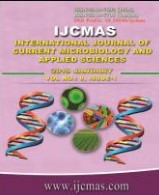


 National Academy of Agricultural Sciences (NAAS)
National Academy of Agricultural Sciences (NAAS)

|
PRINT ISSN : 2319-7692
Online ISSN : 2319-7706 Issues : 12 per year Publisher : Excellent Publishers Email : editorijcmas@gmail.com / submit@ijcmas.com Editor-in-chief: Dr.M.Prakash Index Copernicus ICV 2018: 95.39 NAAS RATING 2020: 5.38 |
School age is the active growing phase of childhood. Primary school age ia a dynamic period of physical growth as well as of mental development of the child. Understanding the nutritional status of children has far reaching implications for the better development of future generations. The present study was undertaken to assess the nutritional status of 90 school going girls by assessing their general information, anthropometric measurements, and dietary assessment. Dietary assessment was done by 24 hour dietary recall method for three consecutive days. Anthropometric measurements were used to construct indices for malnutrition that were compared to reference values. The results of the study revealed that majority of the subjects (75.0 percent) belonged to Hindu religion, MIG and were vegetarian (70.4-81.8%). Height and weight of the subjects were found to be 99.57 - 100.06 percent and 95.08 – 95.5 percent of the NCHS standards respectively. McLaren classification revealed moderate malnutrition (12.2%), mild malnutrition (23.3 %) and overweight (9.0%) based on weight. According to anthropometric indicator of BMI, majority of the subjects (56.7-60%) belonged to normal category BMI with their mean 14.35, 14.42 and 14.64 kg/m² for the age group of 7, 8 and 9 years respectively. The percent adequacy of food intake was ranging from (53.9-98.2 percent). The percent adequacy of nutrient intake ranged from 77.31-132.51 percent. Awareness programs regarding affordable but nutritious foods should be introduced by the government through community participation and other sectors.
 |
 |
 |
 |
 |